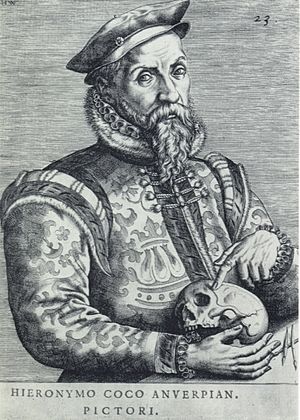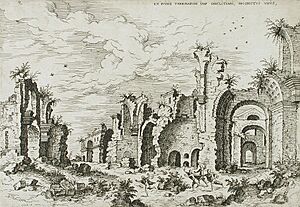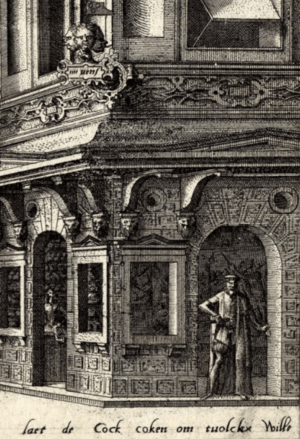Hieronymus Cock facts for kids
Quick facts for kids
Hieronymus Cock
|
|
|---|---|

Portrait of Hieronymus Cock by Johannes Wierix
|
|
| Born | 1518 |
| Died | October 1570 (aged 51–52) Antwerp
|
| Known for | Painting, printmaking, printing |
| Movement | Renaissance |
Hieronymus Cock (1518 – 3 October 1570) was a Flemish artist. He was a painter and an etcher, but he was even more famous as a publisher. He printed and sold many prints.
Hieronymus Cock is known as one of the most important print publishers in northern Europe during his time. His publishing company helped change printmaking. It went from being something individual artists did to a bigger industry with many people working together. His company published over 1,100 prints between 1548 and his death in 1570. This was a huge number for that time!
Even though he was a very important publisher, Cock was also a talented artist. You can see this in his last series of 12 landscape etchings from 1558. These etchings have a fantastic style, similar to the paintings of his brother, Matthys Cock. In total, he created 62 etchings.
Contents
Early Life and Career
Hieronymus Cock came from an artistic family. His father, Jan Wellens de Cock, and his brother, Matthys Cock, were both painters and draftsmen. Hieronymus became a master painter in the Guild of Saint Luke in Antwerp in 1545.
He lived in Rome from 1546 to 1547. When he returned to Antwerp in 1547, he married Volcxken Diericx. In 1548, he and his wife started their publishing company. They called it Aux quatre vents or In de Vier Winden, which means "House of the Four Winds."
The House of the Four Winds
The "House of the Four Winds" published its first prints in 1548. Most of Cock's prints were made after paintings or designs. These designs were created especially for him by artists from the Low Countries. Some famous artists he worked with include Frans Floris, Pieter Brueghel the Elder, Lambert Lombard, Maarten van Heemskerck, and Hieronymus Bosch. He also published designs for buildings and decorations by Cornelis Floris and Hans Vredeman de Vries.
Cock hired some of the best engravers of his time. These included Johannes Wierix, Adriaen Collaert, Philip Galle, Cornelis Cort, and the Italian artist Giorgio Ghisi.
In 1559 and 1561, he published two series of landscape prints. These were made by an unknown Flemish artist now called the Master of the Small Landscapes. The landscapes showed scenes from nature around Antwerp. They greatly influenced how Flemish and Dutch artists painted realistic landscapes.
Spreading Art and Ideas
The Aux Quatre Vents publishing house was very important for sharing Italian High Renaissance art across northern Europe. Cock published prints made by famous engravers like Giorgio Ghisi and Cornelis Cort. These prints were based on works by leading Italian painters such as Raphael and Giulio Romano.
The Italian architecture historian Vincenzo Scamozzi copied many of Cock's engravings. He used them in his book about Rome, published in 1583.
Hieronymus Cock also worked with the Spanish mapmaker Diego Gutiérrez. Together, they created a Map of America in 1562.
Cock also worked with the Antwerp architect Cornelis Floris de Vriendt. They published Floris's designs for monuments and decorations. These books helped spread the "Floris style" throughout the Netherlands.
The Dutch publisher Philip Galle worked at Cock's printing house starting in 1557. He took over the business when Cock passed away in 1570.
Famous Artists' Portraits
When Hieronymus Cock died in 1570, he left behind the most important print publishing company in northern Europe. His wife, Volcxken, continued to run the business until her death in 1601.
In 1572, Volcxken published a book by Dominicus Lampsonius. It was called Pictorum aliquot celebrium Germaniae inferioris effigies. This means "Portraits of some famous painters of Lower Germany." The book had 23 engraved portraits of artists. Each portrait had a short poem in Latin below it. Hieronymus Cock had been working on this book before he died.
The quality of these 23 prints was amazing. They were made by some of the best engravers of the time, like Johannes Wierix and Adriaen Collaert.
The artists featured in the book included: Hubert van Eyck, Jan van Eyck, Hieronymus Bosch, Rogier van der Weyden, Pieter Bruegel the Elder, and Hieronymus Cock himself. The book also included a poem by Lampsonius. This poem honored Hieronymus Cock and praised his widow's work.
The portraits and texts in the book celebrated earlier generations of Dutch and Flemish artists. This book helped create a list of famous artists from the Netherlands. This happened even before Karel van Mander published his own biographies of artists in 1604.
Where to See His Work
Hieronymus Cock's prints and artworks are kept in many museums around the world. You can find his work in places like the Museum of New Zealand Te Papa Tongarewa, the British Museum, the Metropolitan Museum of Art, and the Philadelphia Museum of Art.
See also
 In Spanish: Hieronymus Cock para niños
In Spanish: Hieronymus Cock para niños



